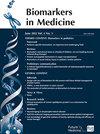RAP1-GTPase immunostaining is altered in human precancerous and cancerous cervical lesions.
IF 1.9
4区 医学
Q3 MEDICINE, RESEARCH & EXPERIMENTAL
引用次数: 0
Abstract
Aim: This study investigated RAP1 immunostaining variation in different cell types during CC progression.Methods: Paraffin-embedded cervical tissues from 101 patients were categorized into control, pre-neoplastic and neoplastic groups. RAP1 immunolocalization, HPV detection and genotyping were performed. A semiquantitative immunoreactive score was employed to compare labeling intensity, cellular localization, nuclear labeling, percentage and distribution of reactive cells.Results: 73% (72/99) of cervical specimens were HPV+. RAP1 was localized in the nucleus and cytoplasm of all samples. Cytoplasmic RAP1 immunoscore was higher than nuclear score in all CC groups. RAP1 intensity increased with lesion severity. SCC samples exhibited predominantly intense RAP1 immunostaining.Conclusion: RAP1 is an efficient biomarker for detecting invasive CC lesions but has limited utility in distinguishing SCC grades.人类癌前病变和癌症宫颈病变中的 RAP1-GTPase 免疫染色发生了改变。
目的:本研究探讨了RAP1免疫染色在CC进展过程中不同细胞类型中的变化:方法:101 例患者的石蜡包埋宫颈组织被分为对照组、肿瘤前组和肿瘤组。进行 RAP1 免疫定位、HPV 检测和基因分型。采用半定量免疫反应评分法比较标记强度、细胞定位、核标记、反应细胞的百分比和分布:73%(72/99)的宫颈标本为 HPV+。RAP1定位于所有样本的细胞核和细胞质中。在所有 CC 组中,细胞质 RAP1 免疫评分均高于细胞核评分。RAP1 的强度随病变严重程度而增加。SCC样本主要表现出强烈的RAP1免疫染色:结论:RAP1是检测浸润性CC病变的有效生物标记物,但在区分SCC等级方面作用有限。
本文章由计算机程序翻译,如有差异,请以英文原文为准。
求助全文
约1分钟内获得全文
求助全文
来源期刊

Biomarkers in medicine
医学-医学:研究与实验
CiteScore
3.80
自引率
4.50%
发文量
86
审稿时长
6-12 weeks
期刊介绍:
Biomarkers are physical, functional or biochemical indicators of physiological or disease processes. These key indicators can provide vital information in determining disease prognosis, in predicting of response to therapies, adverse events and drug interactions, and in establishing baseline risk. The explosion of interest in biomarker research is driving the development of new predictive, diagnostic and prognostic products in modern medical practice, and biomarkers are also playing an increasingly important role in the discovery and development of new drugs. For the full utility of biomarkers to be realized, we require greater understanding of disease mechanisms, and the interplay between disease mechanisms, therapeutic interventions and the proposed biomarkers. However, in attempting to evaluate the pros and cons of biomarkers systematically, we are moving into new, challenging territory.
Biomarkers in Medicine (ISSN 1752-0363) is a peer-reviewed, rapid publication journal delivering commentary and analysis on the advances in our understanding of biomarkers and their potential and actual applications in medicine. The journal facilitates translation of our research knowledge into the clinic to increase the effectiveness of medical practice.
As the scientific rationale and regulatory acceptance for biomarkers in medicine and in drug development become more fully established, Biomarkers in Medicine provides the platform for all players in this increasingly vital area to communicate and debate all issues relating to the potential utility and applications.
Each issue includes a diversity of content to provide rounded coverage for the research professional. Articles include Guest Editorials, Interviews, Reviews, Research Articles, Perspectives, Priority Paper Evaluations, Special Reports, Case Reports, Conference Reports and Company Profiles. Review coverage is divided into themed sections according to area of therapeutic utility with some issues including themed sections on an area of topical interest.
Biomarkers in Medicine provides a platform for commentary and debate for all professionals with an interest in the identification of biomarkers, elucidation of their role and formalization and approval of their application in modern medicine. The audience for Biomarkers in Medicine includes academic and industrial researchers, clinicians, pathologists, clinical chemists and regulatory professionals.
 求助内容:
求助内容: 应助结果提醒方式:
应助结果提醒方式:


